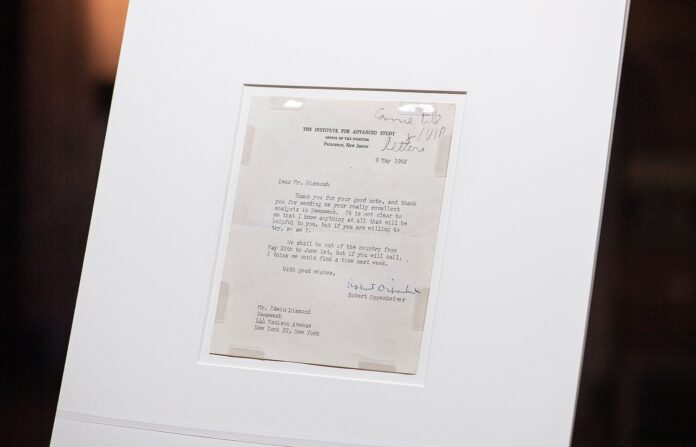ANNAPOLIS JUNCTION, Md. — On what would have been a peaceful day in Hiroshima, Japan, on 6 August 1945, the Enola Gay, a Boeing B-29 Superfortress bomber, dropped an atomic bomb, leaving a mushroom cloud of smoke and more than 135,000 casualties in its wake.

The five artifacts we have on display, none of them are cryptologic artifacts, but they are part of telling a broader story about cryptologic history,” said NCM Director Vince Houghton.
NCM’s Atomic Age exhibit opened earlier this year to memorialize the Trinity Test and the anniversary of Hiroshima, and runs through September. The exhibit also includes a letter to Newsweek editor Edwin Diamond from American physicist J. Robert Oppenheimer, the father of the atomic bomb, a shutter removed from one of the nuclear weapon test houses, and trinitite – a piece of glass created during the “Trinity Test” detonation of the first atomic bomb in the New Mexico desert.
The Manhattan Project
According to Houghton, the Atomic Age exhibit focuses specifically on the top-secret Manhattan Project, which resulted in the creation of the first atomic bombs, including “Little Boy,” the bomb dropped on Hiroshima. Historical accounts show how thousands of scientists working on the project had to first prove that a chain reaction would work and lead to detonation. Codes and ciphers were vital to describing the scientists’ progress.
In 1945, a call transferred from Chicago to Boston saying, “The Italian explorer has reached the new world.” This coded message informed leaders that Edward Fermi, one of the scientists behind the Manhattan Project, had successfully tested the first-ever nuclear reactor.
You kind of look at that as a very rudimentary, early form of what NSA does at a very advanced level,” Houghton said. “It’s almost quaint how they were trying to figure out ways to tell these stories [in code].
Pieces of History
The artifacts found in the Atomic Age exhibit showcase the development of the atomic bomb, from its creation to its usage in helping bring an end to the Second World War. According to Houghton, this exhibit highlights an incredibly important part of American history in both cryptography and harnessing nuclear energy.
I hope that people walk away with the sense of amazement that they are looking at living history,” Houghton said. “They are not just looking at a piece of paper, they are not just looking at some machine, but they are looking at things that were pulled out of the rubble of Hiroshima.
The Atomic Age display is the latest in NCM’s rotating exhibit, which most recently featured encrypted love letters from World War II. Click here for more information about the NCM.



